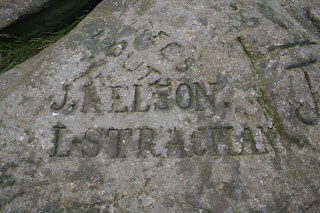
In Parkers 1992 installation ‘Words That Defy Gravity’ the artist fashioned words out of lead to form a dictionary definition of gravity. Then one by one, she flung them from the White Cliffs of Dover (symbolically thought of as the outermost edge of England, where certainty ends and uncertainty begins)
There is a photo of Cornelia Parker in the process of creating this cartoon death. It is quite a dizzy photograph, of her standing inches from the edge, her arm high and her hand at point of release. A word hangs momentarily suspended in mid air before plummeting to meet the rocks below. The word will fall but the artist’s gaze runs counter to its fate. Instead of looking down towards the rocks, she looks out towards the sea as if dreaming of elsewhere. In this suspended moment that the photograph creates nothing is fixed and anything is possible. Time and the pull of gravity are suspended in the space of the artist’s imagination. To complete the work, Parker collected the lead words, mangled by the fall, and suspended them on threads just above gallery floor level. Parker says “the words got made illegible by real gravity,”
















































